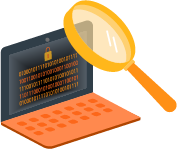Even in the exciting field of artificial intelligence (AI) and automation, generative AI or GenAI stands out as particularly fascinating. Across industries, businesses are in hot pursuit of GenAI tools for different use cases. The benefits that generative AI systems provide are unlike other technologies, which is why it’s arguably one of the most talked-about and debated technologies in the world.
While the use of generative AI has limitless potential, like any other exciting technology, there are security risks that businesses need to mitigate. In this article, we’ll take a look at the security risks of generative AI and provide some actionable advice on what security measures can address them.
But before we dive into the world of GenAI security, let’s get on the same page about what generative AI is.
What is GenAI?
Generative AI apps work by taking what you ask for—a prompt—and using what they've learned to provide an answer or create some kind of media content. This content can be in the form of text, image, code, audio, or video.
Generative AI is a little different compared to other forms of machine learning (ML) because it can do a lot more than a handful of pre-programmed tasks. GenAI can generate content and insights that didn’t exist before. A mathematical solution, a financial projection, even a song.
So, how does generative AI work? It learns by analyzing vast datasets and can then use that knowledge for decision-making and generating new content. The cherry on top of the cake is that the new content typically sounds very realistic and believable.
If AI-generated content sounds believable, it’s because of well-trained generative AI models. These models use algorithms, which are basically just a set of instructions, to ingest information from different sources. One of the most famous examples of generative AI is ChatGPT, a large language model (LLM) that can generate highly realistic content.
The more data you feed GenAI applications, the smarter and more capable they become. That’s why so many companies are using generative AI in applications like chatbots, design tools, and productivity suites. Gartner says companies will invest $644 billion in GenAI capabilities in just 2025. Since generative AI is pretty much everywhere, it’s extra important for businesses to keep an eye on potential security threats.
What are the Security Concerns of Generative AI?
Generative AI technologies have their fair share of unique security issues and vulnerabilities, and it’s very important for businesses to understand and address them.
For example, we know that generative AI applications need a ton of data to function well. But if a certain generative AI application isn’t well-trained or lacks certain foundational knowledge, it might make up false information and mislead users.
There’s also the risk in how we use generative AI solutions. After all, the safety of AI tools depends on how we use them. In the wrong hands, generative AI can be used to generate malicious outputs or launch cyberattacks.
The negative aspects and security risks of generative AI can harm individuals, businesses, and even governments. So what’s important is to gain a deep understanding of potential threats surrounding generative AI and take proactive steps to improve your cybersecurity posture and secure AI development and adoption.
Top 10 Security Risks of GenAI
In this section, let’s get into specific security issues that generative AI can present. Before you read on, don’t forget that it’s not all doom and gloom. Generative AI can be an incredibly productive and useful technology for your organization. All you have to do is work towards mitigating the following security risks.
Exposure of Training Data
Typically, a GenAI application isn’t supposed to reveal the data that it has been trained with. However, on occasions, GenAI applications can accidentally leak training data, which might include sensitive information, business secrets, and intellectual property.
Threat actors can also potentially trick generative AI applications with manipulative inputs to get them to divulge secrets and sensitive data. Sensitive training data leakage doesn’t just break trust—it can also trigger legal trouble and financial penalties.
Misinformation
Since generative AI outputs are often so realistic and believable, misinformation is another major risk. There are two ways that generative AI applications can spread misinformation. The first way involves a malicious actor deliberately generating and sharing fake news reports, messages, or media.
Unfortunately, the second way is that generative AI applications sometimes just generate wrong information. This isn’t malicious or deliberate; instead, it could be due to poor training or a mishmash of confusing prompts. Misinformation can always slip through when using generative AI, even with good intentions.
Bias
With generative AI, businesses also need to watch out for bias. If the training data is biased, there’s a good chance the AI’s output will be too. Since a lot of training data is created by humans, they might include prejudices and stereotypes.
Why should companies care about the risk of biased outputs? Imagine if your company uses a customer-facing genAI chatbot, and that chatbot generates misogynistic or culturally insensitive content. The fallout of such biased outputs can be hard to recover from.
Deepfakes
Deepfakes are a major problem in the era of generative AI. AI-generated deepfakes are media that closely resemble real-world images, videos, or audio. As generative AI becomes more and more advanced, deepfakes become more realistic.
Soon, we’ll see many situations where fake images, videos, or sound clips will be shared publicly to bring disrepute to individuals and organizations. Businesses have to take deepfakes seriously because it’s a reminder of how believable AI-generated content can be used for extremely malicious purposes.
Phishing Attacks
Phishing attacks are a form of social engineering attack that are getting a leg-up from generative AI technologies. Think about phishing attacks from the past: fake emails might have had poor grammar or spelling that indicated that they didn’t come from an official source or user. Thanks to generative AI, it’s harder than ever to tell fake emails and messages from the real thing.
Cybercriminals can use generative AI to disguise themselves as friends, co-workers, bosses, or institutions like banks to try and trick innocent users into sharing sensitive information or sending money. Also, generative AI technologies enable cybercriminals to craft and deploy thousands of fake messages quicker than ever before.
Malware and Ransomware Attacks
With generative AI, malicious actors can easily create their own strains of malware, which is basically any kind of software application that intends to harm a victim’s system. Ransomware is a kind of malware where threat actors essentially lock you out of your IT environments until you pay a ransom.
In the past, creating malware and ransomware required coding capabilities and technical skills. Now, with just a few prompts, any cybercriminal with a laptop, an internet connection, and access to generative AI can launch large-scale attacks.
Data Poisoning and Model Poisoning
Data poisoning and model poisoning are types of adversarial attacks where a threat actor messes with the training data that your GenAI applications use. Typically, threat actors will sneak in some malicious datasets into training data libraries to make legitimate GenAI applications generate biased or false outputs.
These are particularly bothersome security issues because it’s very hard to identify when a data poisoning attack has taken place. Since there are no obvious indicators of compromise, a lot of damage might be done before an enterprise finds out something is wrong.
Data Security and Privacy
Most enterprises would agree that data security and privacy are their most important security priority. With generative AI, there’s a whole horde of data security issues that need to be tackled. One such issue is the privacy of data inputs. When a user enters a prompt, GenAI applications might store that prompt for future use. If that prompt has sensitive data like personally identifiable information (PII) and that data leaks, it could spell serious trouble.
It’s also important to remember that generative AI applications, like every other part of your tech stack, are susceptible to data breaches and unauthorized access, the worst of which could cause long-lasting damage.
Identity Theft and Fraud
Another security concern with generative AI is identity theft, which can open the door to different kinds of fraud. Since GenAI outputs are realistic, malicious actors can impersonate others and generate fake IDs, social media profiles, or messages to commit crimes and trick others.
GenAI applications can even be trained to understand and mimic the nuances of an individual’s way of writing or speaking, which makes fake messages even more believable.
AI Model Theft
Like any other valuable asset, enterprise GenAI applications and models are susceptible to theft. Typically, it takes a lot of time, resources, and skill to develop these applications. That’s why threat actors sometimes look to steal AI models, which allows them to utilize GenAI capabilities without the expenses or labor.
Once threat actors steal an AI model, there’s no way of knowing how they’ll use it. They could use it for malicious purposes or even resell it as their own invention.
How to Mitigate GenAI Security Risks?
Now that we have a handle on the biggest GenAI security risks, let’s shift our focus to how you can avoid them.
Set Up an AI Governance Framework
Companies should introduce a set of simple and actionable rules, protocols, and best practices that establish how generative AI will be used, developed, and deployed in their organization. This should include cybersecurity protections, ethical baselines, risk management, and regulatory guardrails.
Prepare Incident Response Plans
No matter how strong their AI security posture is, businesses should always have incident response plans and playbooks ready to go. In case generative AI security risks mature into large-scale events like data breaches, there should be a step-by-step guide (with roles and responsibilities) to follow to rapidly remediate the incident.
Enforce Data Protections
Data is what makes generative AI solutions tick. However, that also means data related to GenAI applications is always at risk. Businesses should encrypt and anonymize their sensitive data when training GenAI models. Also, companies have to know about AI-related data privacy and protection laws that are specific to their industry and region, and align their data security measures with those requirements.
Communicate with Employees and Stakeholders
Securing generative AI must be a collective effort. Therefore, organizations need to establish communication channels with key stakeholders, conduct GenAI security training and awareness programs for employees, and even reach out to service providers across their supply chain to understand third-party risks.
Optimize Access Controls
Not everyone should be able to access or influence a company’s GenAI infrastructure and data. Therefore, it’s imperative to establish strong access controls and authentication protocols based on principles like zero trust. This ensures that only people who absolutely need GenAI-related resources are given access privileges.
Get AI Security Solutions
GenAI security risks aren’t like other cybersecurity risks. AI security is a whole different animal. Therefore, companies must research and invest in security solutions that are AI-driven. AI-powered security tools, featuring continuous monitoring and real-time analytical capabilities, are better equipped to stay on top of GenAI security risks.
Consider Working with an MSSP
GenAI security can easily become overwhelming, even for companies with good security resources. Therefore, businesses should consider using the skills, resources, and expertise of a Managed Security Service Provider (MSSP). MSSPs have access to tools, threat intelligence, and personnel that the typical business might not, which makes them capable of more efficiently dealing with dangerous GenAI security risks.
Conclusion
There’s no doubt that generative AI is going to change the world, even more than it already has. But if we don’t address the security risks of GenAI now, the future might be more challenging than it needs to be.
Companies should pay close attention to the risks outlined in this article, like misinformation, biases, deepfakes, phishing attacks, and model theft. They should also remember that these risks can be easily mitigated by following best practices like establishing an AI governance framework, setting up access controls, making GenAI security a collective effort, and securing GenAI-related data.
If companies need a little help in protecting their generative AI applications, there’s always the option of working with experienced MSSPs who can resolve even the most complex GenAI security problems.
Categories: Security, Cybersecurity Strategy, Cyber Threats, AI Governance, Zero Trust Architecture, AI Defense, AI in Cybercrime, Security Automation, Deepfake Threats, Proactive Cybersecurity, Endpoint Protection, Cybersecurity Awareness, Generative AI Security, AI Malware, AI Phishing, AI Risk Mitigation, AI Model Theft, AI-Driven Cybersecurity, GenAI Cybersecurity, Phishing with AI, Misinformation and AI, GenAI Data Privacy, GenAI in the Workplace, MSSP for AI Security











